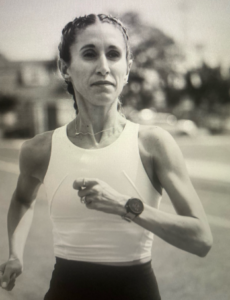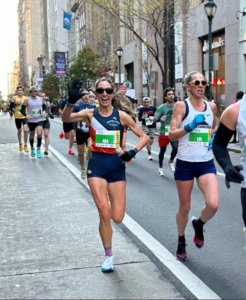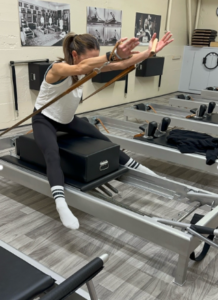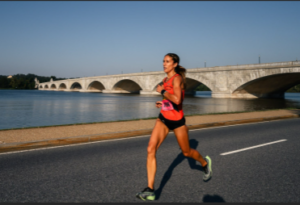By Theresa McCabe
I run, a lot.
I wake up most mornings by 5:15 and am out the door by 5:45 to log my miles before the day begins. I am home by 7:15 and then it is nonstop as I get myself and my three kids ready to be out the door by 8:40. I see my first client of the day at 9:00. There is no room for error and certainly no time for the Instagram version of a leisurely post run routine. That’s not to say there isn’t a routine. The routine I have crafted over the years is honed to perfection for my needs. But it does ask a lot of my 38-year young body. This is where the Pilates comes in.
Pilates is my secret weapon.
I played division three college lacrosse before leaving school to work full time as a bartender, a lifestyle I fully embraced! I found Pilates 16 years ago when I desperately wanted to get some sort of physical fitness back, but in a way that didn’t remotely resemble my former athlete lifestyle. Back then I wasn’t yet an elite athlete, you could say I was barely an athlete at all! I was hooked on Pilates immediately. I continued practicing and picked up running again to lose some weight.
In 2012, after the birth of my first child, I leaned hard into my running and ran my first marathon in 2013. Since then, I have run 9 marathons, lowering my personal record to 2 hours and 49 minutes and my half marathon to 1 hour and 18 minutes. These times are what categorize me as an elite athlete. I have also completed two comprehensive Pilates teaching certifications. I feel that running and Pilates are the perfect marriage.
Stretch and strength are exactly what runners need.
To my client’s surprise, my hamstrings are like the big fat tight rubber bands you see around broccoli stalks. They imagine my reality to be the effortlessly loose legs of the teacher they see on Instagram. Mr. Pilates protégé Romana Kryzanowska is quoted as saying: “You can say what Pilates is in three words. Stretch with Strength and Control. And the control part is the most important because that makes you use your mind”. It’s that control that makes the work look effortless, but it is always work!
Running requires so much more than leg strength. While I certainly work on leg strength in my sessions, I focus more on my core, glutes, back, and shoulders. When you pound endless miles, your body starts breaking down. Typically, you start to round the shoulders or hike them up to your ears. The natural length and space between your hips and ribs starts to compress when you to slouch or fold at the waist.
We’ve all seen runners when you can just tell by looking at them, how much they are hurting. By working on my core, I can stay more upright, keep my chest open and keep my shoulders relaxed down my back, minimizing that pain. That optimal posture is not just about vanity. Every running study done shows that the more you can keep your form together and relaxed the better, faster, and longer you can run. Running is a repetitive movement, largely using your body in one plane and in one direction. Small imbalances to the muscles or gait can easily become magnified until it becomes an injury. Pilates can identify and strengthen these weaknesses, ultimately making you a better runner.
My mental clarity comes during my Pilates sessions.
I often hear about my running that “it must be so good for clearing your mind”. My running often is mentally draining because I am asking my body to push through a lot of pain. I need to willingly enter the pain cave and hang out there. I must stay focused and present to make sure I am hitting my splits. On the easy days I am catching up with my running partners (the best part of running) so there is no mind clearing there either!
Pilates can help improve your mental focus and concentration. This can translate to better focus during your runs. When I practice Pilates or take a lesson, I find that by having to only focus on my body I enter almost a meditative state. Those fifty minutes of peace recharge my mental battery more than anything else I do. In an ideal world I would find time daily for this practice, but I am lucky to fit it in three time a week, which is what Mr. Pilates “prescribed” when he was alive.
I feel that running and Pilates are the perfect marriage.
I am grateful for that time spent on my own Pilates practice and am grateful that a large chunk of my non-workout related time is spent sharing my knowledge and expertise with my clients. Because Pilates is a low-impact activity, runners can fit it into their schedule whenever they have time, without worrying about how it will impact their run the next day.
Ready to give Pilates a try? Come visit me at Evolution Pilates.




